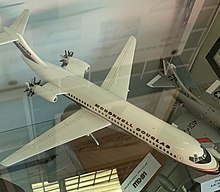McDonnell Douglas MD-94X
[5] Configuration was similar to the MD-80, but advanced technologies such as canard noseplanes,[6] laminar and turbulent boundary layer control, side-stick flight control (via fiber optics), and aluminum-lithium alloy construction were under consideration.
[7] Airline interest in the brand-new propfan technology was weak despite claims of up to a 60% reduction in fuel use, and both aircraft were canceled.
[9] On May 19, 1987, McDonnell Douglas tested General Electric Aviation's unducted fan (UDF) engine in flight for the first time on an MD-80 demonstrator,[10] an aircraft that was restored after suffering an empennage separation in 1980 during the landing of a certification test flight for the DC-9 Super 80.
[11] A propfan-powered military variant of the MD-87 or MD-91X, called the P-9D, was also proposed as an anti-submarine warfare (ASW) aircraft.
[12] In October 1988, the Navy selected a derivative of the P-3 Orion (which was later renamed Lockheed P-7A) as the LRAACA aircraft over the P-9D.
